ALAN ZISMAN ON
TECHNOLOGY
This time, an email scam
By Alan Zisman © 2025-02-20
Another in the ongoing series of online scams - this one involving email. It started this morning, with an email I received, apparently from an aquaintance of mine - let's call her Debbie (not her name).
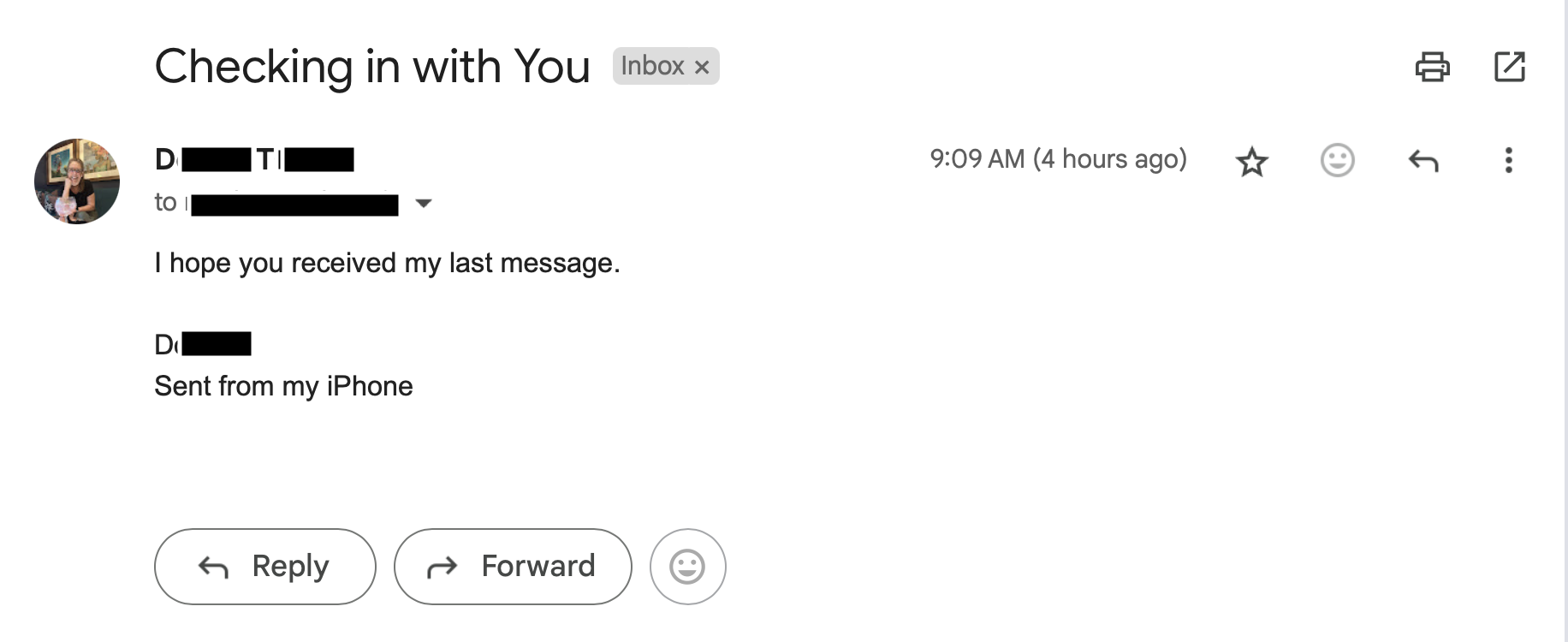
"I hope you received my last message." it read.
Well, no, I hadn't - I checked my spam folder. Nothing. I replied, saying as much, and quickly heard back:
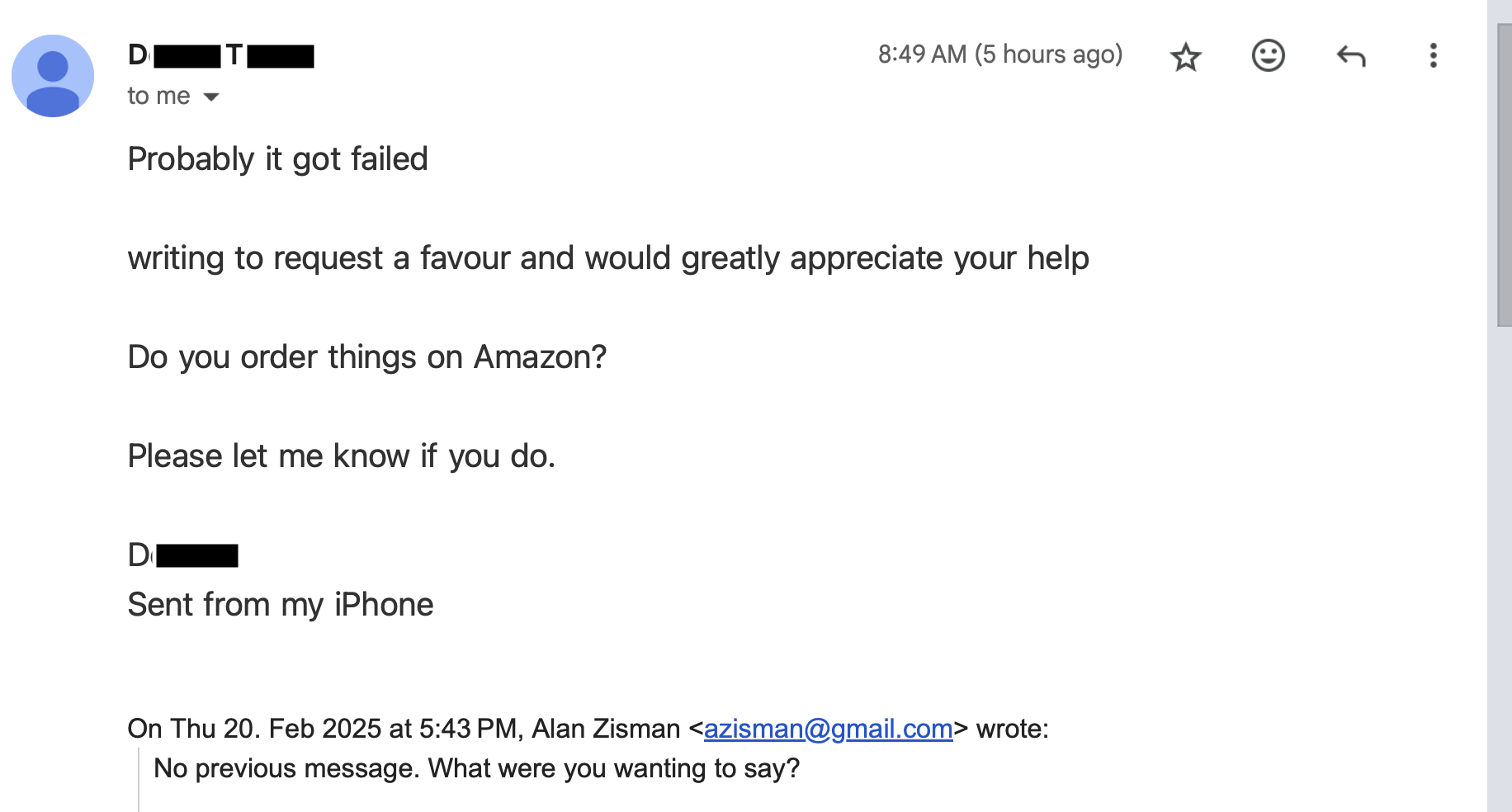
That was enough to make my spidey senses tingle. I know Debbie, but not particularly well... I'm sure there are a hundred people she would be more likely to ask for a favour. And 'order things on Amazon?' Hmmmm. But who knows? So I fired off a question or two, asking for information that Debbie would know, but probably not some random stranger:

Right? If this was really Debbie, I would probably owe her an explanation for my questions. But here's the reply:

Umm - okay, sure. At this point I did two things - first, since Debbie and I are 'friends' on Facebook, I messaged her, saying I was getting odd emails claiming to be her - she confirmed that she thought her email had been 'hacked' - I suggested she change the password and enable 2 Factor Authentication wherever possible.
If this happened to you, this would probably be a good time to just walk away. But I wanted to see where it would go - knowing that I might write a blog post about it, and besides, I'm just curious. So I asked the faux Debbie for more information:

She quickly got back with how I could help:
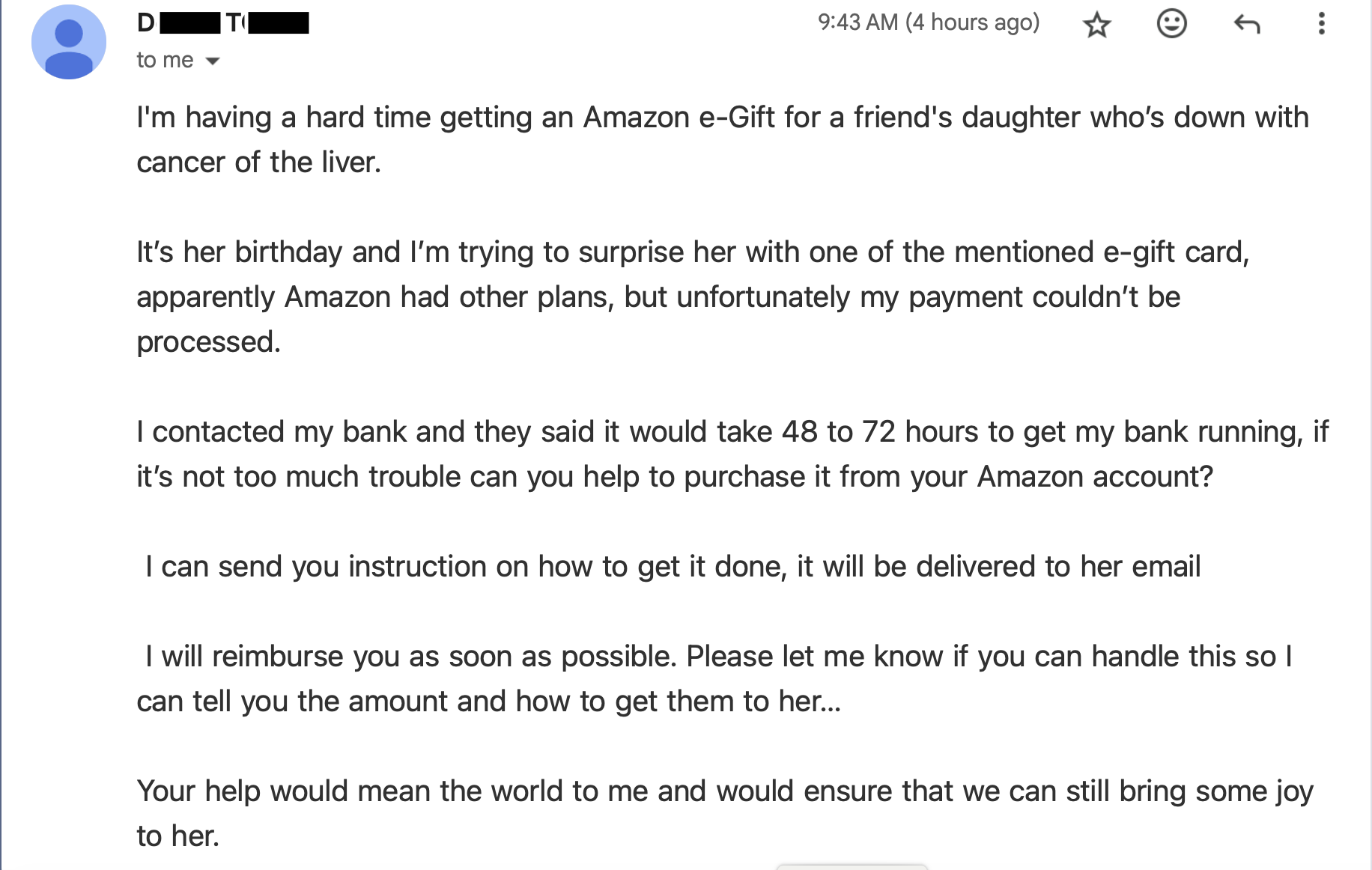
And with a little prompting, more details:
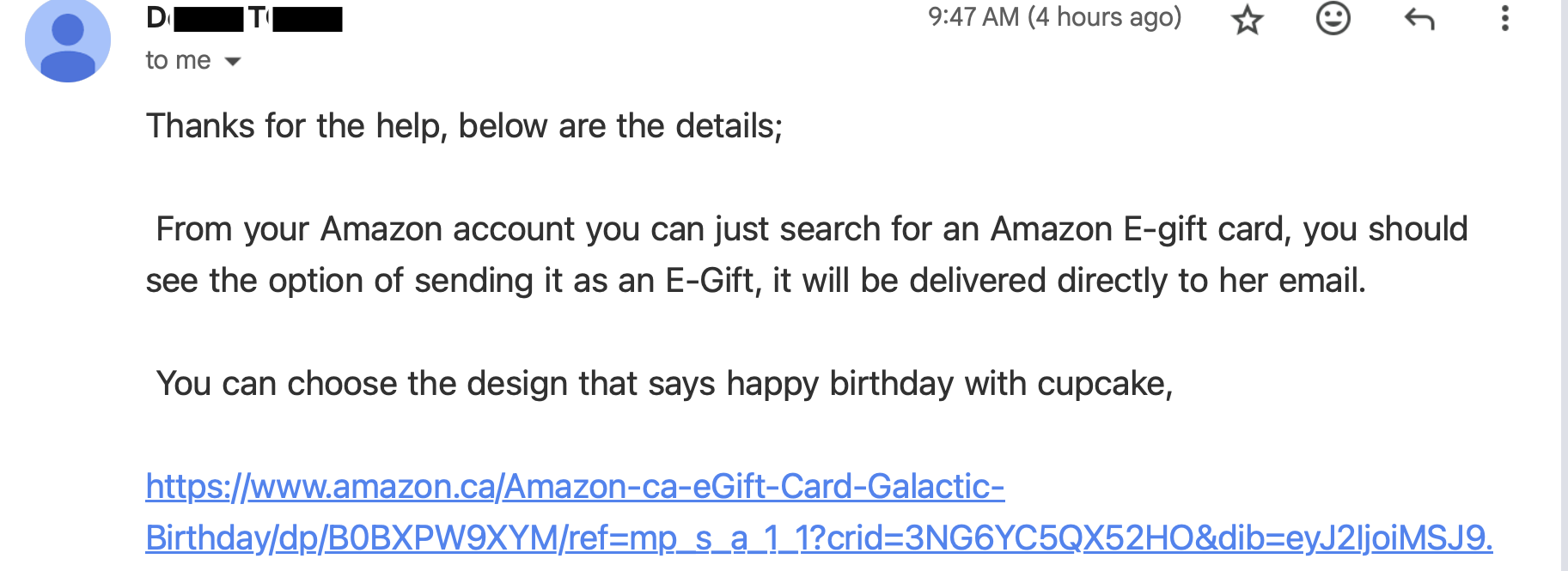
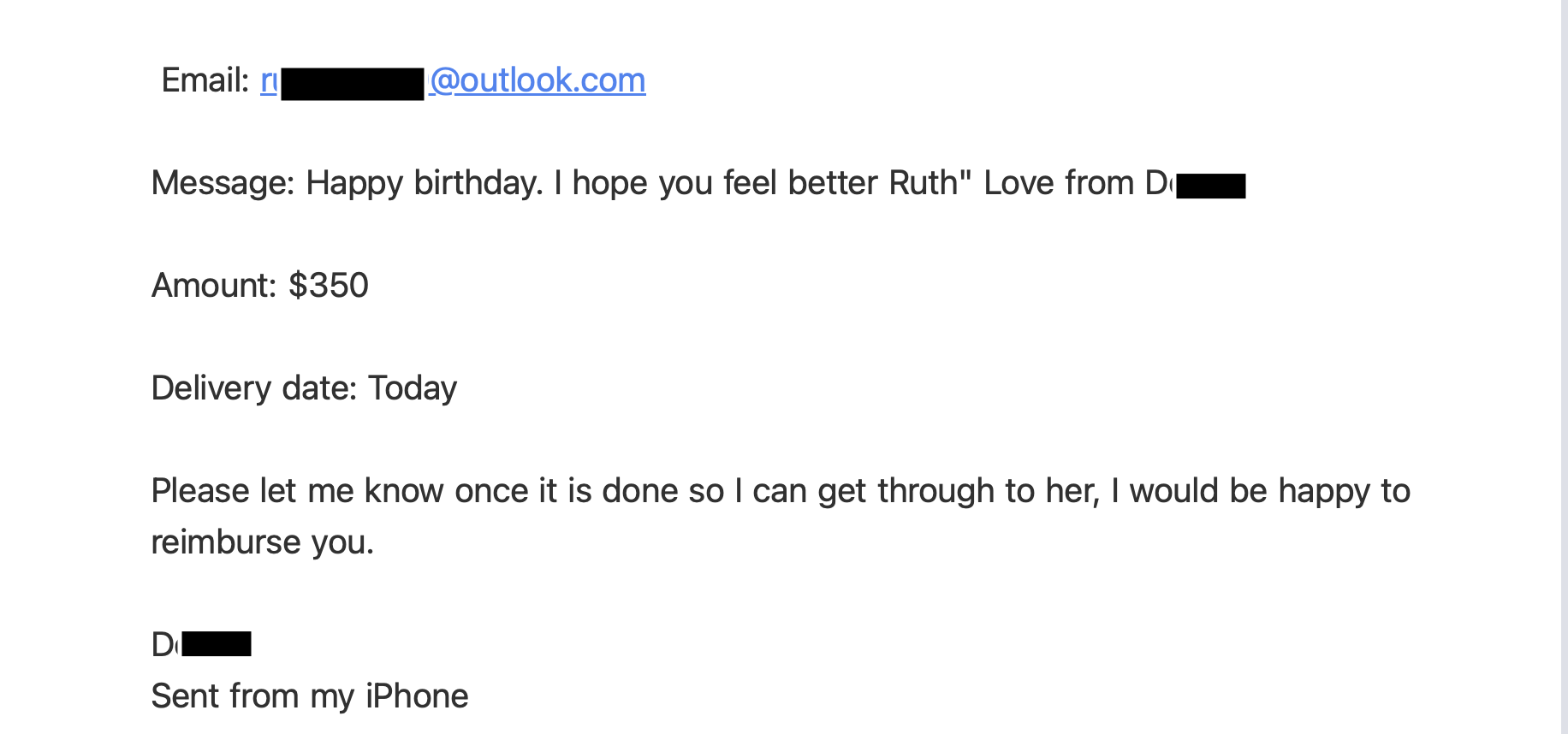
So - I should purchase an Amazon gift card for $350 and send it - along with an e-card (saying 'Happy Birthday' with a picture of a cupcake) to Ruth at an email address starting with the letter 'n' - and I should do it right away because today's her birthday. And Debbie will pay me pack as soon as the problem with her bank gets sorted out in a day or two. No problem.
Instead, I sent her a copy of a Facebook message that Debbie had posted on that service:

I didn't hear back.
Okay - you might have figured out it was a scam pretty quickly. Or maybe not - obviously I wasn' t the only person the faux Debbie contacted. If 99 people quit the conversation after one or two emails, but one follows through and actually sends a $350 Amazon gift card, then the scam emailer has been successful.
And for me, it was pretty obvious from the start that the real Debbie was unlikely to be asking me for help - but what if the person apparently getting in touch was a closer friend or relation - someone who might, in fact, ask me (or you) to bail them out of a jam?
The reason these sorts of things happen is because enough of us fall for them to make them pay off. So don't be fooled. When in doubt, verify! (The same thing is true for news posts on Facebook, Instagram, etc by the way - even if you'd like them to be true! For those, fact-checking site Snopes.com is a good resource).
And please - for any online accounts where you can - email, social media, banks and credit unions, and more - enable 2 Factor Authentication. This makes it much harder for scammers to take over your account. 2FA can be a pain, I know - but so is locking your front door. Get serious, enable 2 FA!
- How to enable two factor authentication forGmail and for Facebook
- How to enable two factor authentication forother services
Older blog postings....
This time, an email scam
By Alan Zisman © 2025-02-20
Another in the ongoing series of online scams - this one involving email. It started this morning, with an email I received, apparently from an aquaintance of mine - let's call her Debbie (not her name).

"I hope you received my last message." it read.
Well, no, I hadn't - I checked my spam folder. Nothing. I replied, saying as much, and quickly heard back:

That was enough to make my spidey senses tingle. I know Debbie, but not particularly well... I'm sure there are a hundred people she would be more likely to ask for a favour. And 'order things on Amazon?' Hmmmm. But who knows? So I fired off a question or two, asking for information that Debbie would know, but probably not some random stranger:

Right? If this was really Debbie, I would probably owe her an explanation for my questions. But here's the reply:

Umm - okay, sure. At this point I did two things - first, since Debbie and I are 'friends' on Facebook, I messaged her, saying I was getting odd emails claiming to be her - she confirmed that she thought her email had been 'hacked' - I suggested she change the password and enable 2 Factor Authentication wherever possible.
If this happened to you, this would probably be a good time to just walk away. But I wanted to see where it would go - knowing that I might write a blog post about it, and besides, I'm just curious. So I asked the faux Debbie for more information:

She quickly got back with how I could help:

And with a little prompting, more details:


So - I should purchase an Amazon gift card for $350 and send it - along with an e-card (saying 'Happy Birthday' with a picture of a cupcake) to Ruth at an email address starting with the letter 'n' - and I should do it right away because today's her birthday. And Debbie will pay me pack as soon as the problem with her bank gets sorted out in a day or two. No problem.
Instead, I sent her a copy of a Facebook message that Debbie had posted on that service:

I didn't hear back.
Okay - you might have figured out it was a scam pretty quickly. Or maybe not - obviously I wasn' t the only person the faux Debbie contacted. If 99 people quit the conversation after one or two emails, but one follows through and actually sends a $350 Amazon gift card, then the scam emailer has been successful.
And for me, it was pretty obvious from the start that the real Debbie was unlikely to be asking me for help - but what if the person apparently getting in touch was a closer friend or relation - someone who might, in fact, ask me (or you) to bail them out of a jam?
The reason these sorts of things happen is because enough of us fall for them to make them pay off. So don't be fooled. When in doubt, verify! (The same thing is true for news posts on Facebook, Instagram, etc by the way - even if you'd like them to be true! For those, fact-checking site Snopes.com is a good resource).
And please - for any online accounts where you can - email, social media, banks and credit unions, and more - enable 2 Factor Authentication. This makes it much harder for scammers to take over your account. 2FA can be a pain, I know - but so is locking your front door. Get serious, enable 2 FA!
- How to enable two factor authentication forGmail and for Facebook
- How to enable two factor authentication forother services
Older blog postings....
| About This Blog... I've been writing about computers, software, Internet and the rest of technology since 1992, including a 17 year (1995-2012) stint as 'High Tech Office' columnist for Business in Vancouver. This blog includes thoughts on technology, society, and anything else that might interest me. Comments, emailed to alan@zisman.ca are welcome - and may be published in whole or part. You can follow me on Twitter or Google + for notice of new blog postings. |
 |